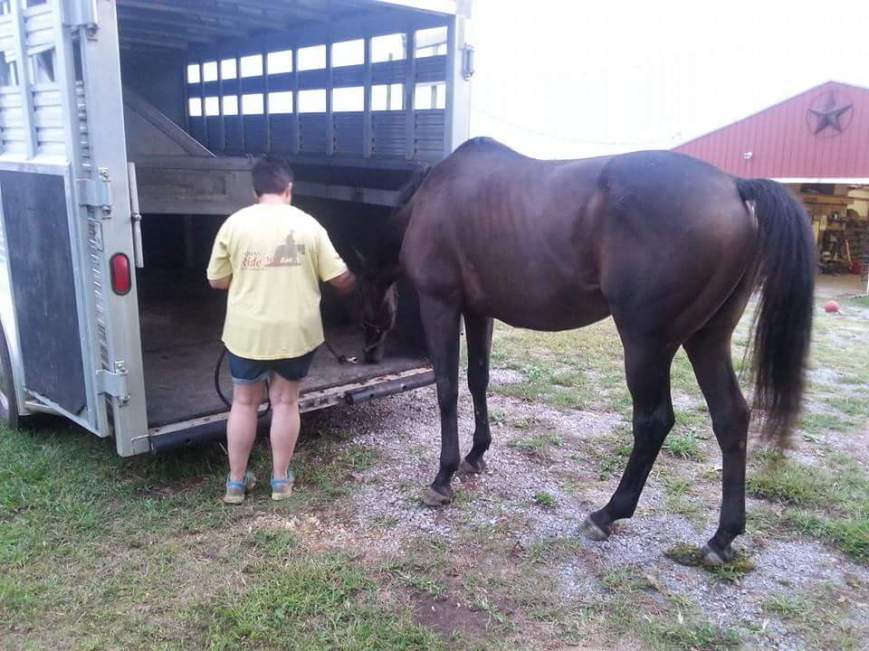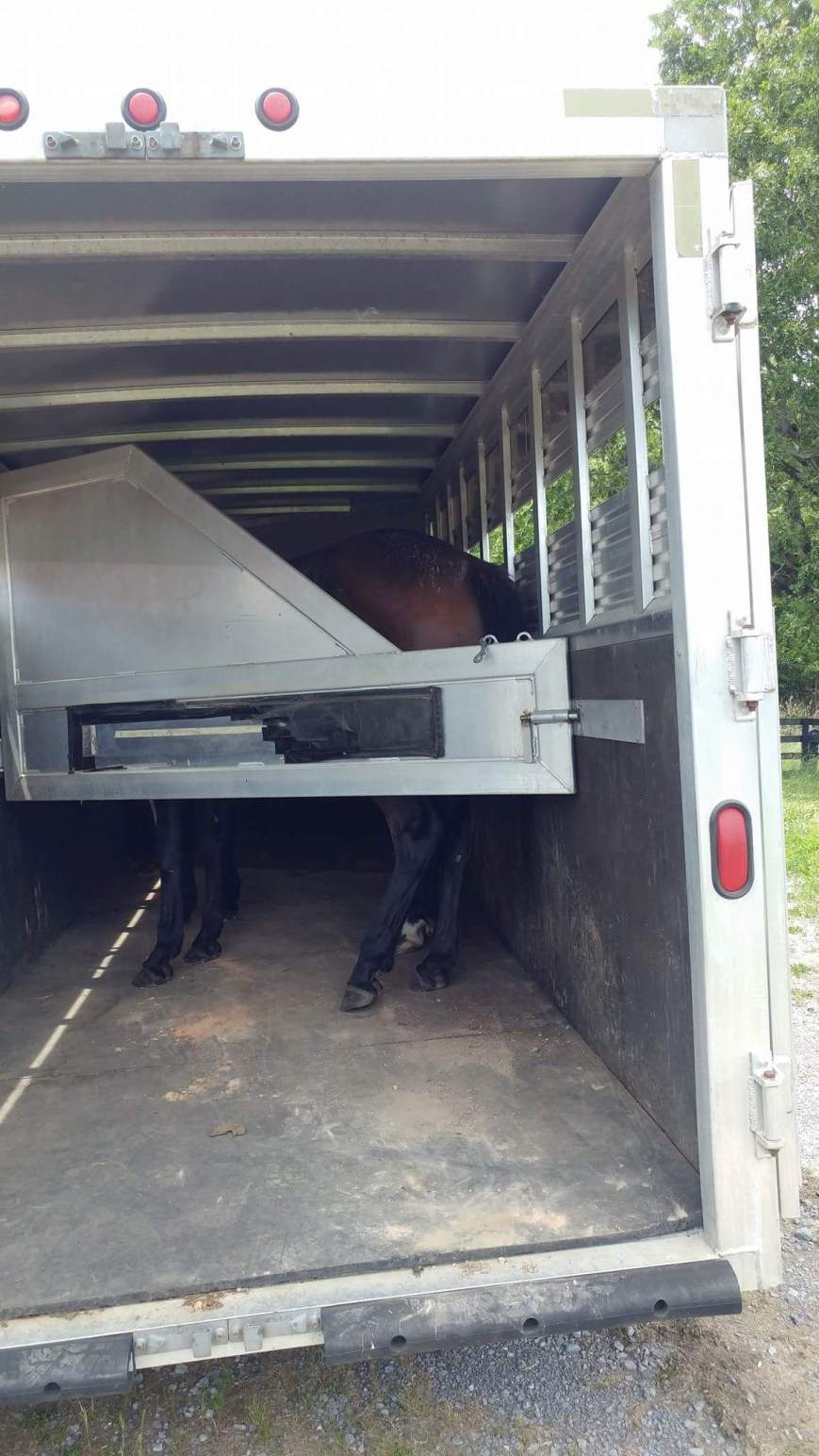While there’s a ton of great information out there about getting horses to load on trailers, it’s still an issue that owners often deal with, and it’s a question that is frequently posted on forums and Facebook pages.
Most often, the root cause traces back to not having a foundation on a horse – being able to control their feet lightly – before ever trying to get them on the trailer, or they’re asking the horse for the next step too soon.
Here’s some simple big picture points to keep in mind any time you’re working with your horse. The same principal applies no matter what you’re doing.
- Horses have the mental capacity of a three year old child – always keep that in mind.
- Horses learn by repetition.
- Quit asking for anything when they give you the slightest try.
- Make the right thing easy (rest) and the wrong thing hard (work)
- Always end on a good note even if you have to set them up to get it.
- Encourage curiosity and you build confidence.
So applying this to trailer loading and unloading….
- Before you ever approach the trailer, make sure your horse knows how to move forward on their own.
You need to be able to point or tap at the hip and they move forward without hesitation. The reason they need this is so they load on to the trailer by themselves.
- You need to be able to move all four feet forward, backward, and sideways by a simple easy tug of the lead rope.
Think of a showmanship horse. They can get a horse to square up or do a pivot by moving the lead just an inch or two. When you’re loading your horse and asking them to put a foot on or take a foot off, you need that same lightness.
- Make the trailer a place of rest and away from or off the trailer a place of work.
If your horse wants to go away from the trailer, let him but put his feet to work. Then come back to the trailer – or as close as you can – to let him rest.
- Don’t immediately make your horse get close to the trailer if they’re afraid of it.
If you horse starts acting up six feet from the trailer, don’t automatically try to get them right next to the trailer. Instead, ask them to work their feet at seven feet away and gradually move in closer. Don’t ask them to move closer until they’re relaxed at the distance they are already at.
- Ask them to put one foot on and off a million times until they’re bored and falling asleep.
You need to ask for it so many times that the horse is completely relaxed and keeping their foot on the trailer on their own. If they want to take the foot off, let them but ask for it to go right back on and leave them alone. Too many times people ask them for that next step too soon and the horse regresses in their training.
- Ask them two feet on and off a million times, then three feet a million times, then four feet a million times.
The same principal applies to the rest of the feet. Ask them to put that same foot so many times that they’re comfortable with it and keeping those feet in place on their own. If you get three feet on and they want to back out, let them back out and then ask them to come right back and try again. Don’t ask for that fourth foot until they’re keeping those three feet on by themselves.
- Because they’ve already loaded and unloaded all four feet a million times, they already know how to unload as a side effect.
Horses want to come off the trailer for two reasons.
- One is they are truly not comfortable being on the trailer – they need more work on being taught to load until they are.
- Two is that they’re anticipating coming off – remember horses learn by repetition?
Think about your hauling and unloading routine. Do you have the same process every time you haul somewhere or when you come home? Change it up and keep your horse guessing when they’re coming out of the trailer. Instead of unloading as soon as you stop, try opening one door and waiting a while. Then open another door and wait again. When you go to unload, unload them and put them right back on and then unload for the day. Anything to mix up the routine will help.
A few thoughts on safety…
- My number one safety rule is to make sure they are untied any time the divider is open or the butt bar is down.
- I don’t tie until they’re locked in, and I always untie before I open the divider or unsnap the butt bar.
- If a horse isn’t comfortable staying on the trailer on their own, don’t shut them in.
Wait until they’re standing on the trailer and not coming off before you shut and latch the divider or trailer door. If a horse is scared of being in a trailer, locking them in is not going to magically cure the fear. It’s only going to make them feel trapped.
- Pay attention to how you drive.
- Horses will start having trailer trouble if your driving is causing them to become unbalanced.
- Be slow and gradual with your stops.
- Take turns slowly and easily – be sure to gradually slow down when coming into a turn.
- Wait to accelerate coming out of a turn until your trailer is completely through the turn.
- Gradually accelerate.
A few more tips…
- Incorporate your trailer training into your daily turnout routine
Every time you turn your horse in and out, you can spend a couple of minutes on trailer work. You don’t have to fully load your horse. Just ask for a step or two on and off the trailer and then quit. Be sure to quit on a good note.
- Haul your horse to town for simple errands. When a horse is getting used to hauling, frequent short trips are a good way to get some seasoning.
- Don’t get in a hurry – no matter what. Horses are a mirror of our emotions and frame of mind, and our body language. If you feel yourself getting impatient or worried because you have somewhere to be, take a big breath that your horse can hear. Horses look to us to be leaders. If we’re calm and confident, they will be too.
How well does your horse load? What steps can you take to help your horse load better?





Great info and insights :)) I love loading and hauling my wonderful homebred horses to destination trail rides. Our trailer is a bit small, but they are like kids in the family station wagon — since they literally grew up in our Logan three horse slant trailer, they hop in willingly, haul quietly, and don’t complain :)) Dawn
https://soulhorseride.wordpress.com/2017/10/10/horse-human-ultimate-unity/
LikeLike
Thanks for reading the blog. Sounds like you did an excellent job with your horses!
LikeLiked by 1 person
Thank you :)) I feel very fortunate to have such a relationship with these intelligent and willing beings! They carry us into realms of magic :)) :)) I’m not sure how many of us “horse dreamers” really get to enjoy the depth that’s possible. It’s the “Pearl of great price” — pretty amazing!!!
LikeLiked by 1 person
Excellent material! My difficulties with loading the horse into the trailer ended when we purchased a trailer larger than the previous one. What was my surprise, because I thought that I just had too restless a horse!!
LikeLike